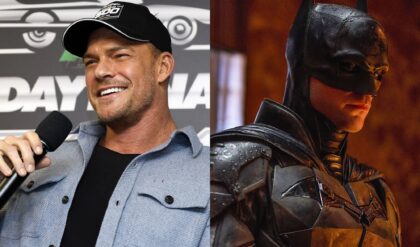In the heart of America’s Midwest, where tulip fields bloom like blood-red secrets under a too-perfect sky, lies a town that looks like a postcard from a forgotten fairy tale. Holland, Michigan, isn’t just a dot on the map—it’s a meticulously curated illusion of Old World charm transplanted into the rustbelt, complete with windmills creaking like whispering ghosts and streets lined with clogs that could double as weapons in a nightmare. Now, imagine that idyllic facade cracking open to reveal something rotten at its core: infidelity, murder, and a conspiracy so twisted it makes the Stepford Wives look like a rom-com. Enter Nicole Kidman, Hollywood’s chameleon queen of unease, starring as the unraveling homemaker at the center of Holland, a 2025 psychological thriller that’s already sending shivers down spines since its March debut on Prime Video. Directed by the audacious Mimi Cave—fresh off her cannibalistic debut Fresh—this film doesn’t just play with suburban paranoia; it weaponizes it, turning a tulip festival into a descent into madness. If you’ve ever suspected your neighbor’s smile hides teeth, Holland is the mirror you didn’t know you needed. Buckle up, because Kidman’s about to make your picket fence feel like a prison.
To understand why Holland hits like a Dutch oven slamming shut on your sanity, you have to start with the town itself. Founded in 1847 by Dr. Albertus C. Van Raalte, a Dutch Reformed minister fleeing religious persecution in the Netherlands, Holland was born from desperation and devotion. Van Raalte led a ragtag band of about 800 immigrants across the Atlantic, landing in New York before trekking westward to the wilds of Ottawa County. They chose this spot on the banks of Lake Macatawa—a shimmering inlet feeding into Lake Michigan—for its fertile black soil and promise of isolation from the corrupt Old World. But paradise came with a price. The newcomers plowed right into the territory of the Ottawa (Odawa) people, whose Old Wing Mission Colony had thrived there for generations. What followed wasn’t the harmonious melting pot of American myth; it was theft and displacement. Dutch settlers pilfered sugar maple sap and venison from Native stores, clashing culturally over everything from Catholic influences to traditional practices. By the 1850s, the Ottawa were herded northward to Allegan County, their way of life eroded like the dunes along the lakeshore. Whispers of that original sin linger in Holland’s soil, a foundational unease that the film exploits masterfully.
Fast-forward to today, and Holland has ossified into a living diorama of Dutch nostalgia, a theme park masquerading as a city of 34,000 souls. Windmill Island Gardens boasts “De Zwaan,” a 240-year-old behemoth imported from the Netherlands in the 1960s, its sails grinding flour while tourists snap selfies below. Nelis’ Dutch Village recreates a 16th-century settlement with stroopwafels, Delftware pottery, and wooden-shoe factories where visitors clomp around like escaped extras from a folk festival. And then there’s Tulip Time, the annual May extravaganza that’s the town’s lifeblood. Since 1929, it’s drawn half a million visitors to gawk at six million bulbs exploding in crimson, yellow, and violet riots across 30-acre gardens. Klompen dancers in embroidered klederdracht skirts stomp to oompah bands, bitterballen vendors hawk fried meatballs, and parades snake through streets where every lamppost flies the Dutch flag. It’s wholesome, it’s photogenic, it’s a $50 million economic jolt. But peel back the petals, and the eeriness creeps in. Holland feels less like a community and more like a cult of preservation, where the past is embalmed in syrupy excess. Dutch descendants—still a majority—cling to Reformed Church values, their tidy lawns and steepled skyline evoking a piety that’s equal parts charming and claustrophobic. Online forums buzz with outsiders calling it a “fake Netherlands,” a surreal bubble where authenticity wars with artifice. In Holland, Cave leans into this uncanny valley, transforming tulip fields into hallucinatory mazes and windmills into looming sentinels, as if the town’s very existence is a polite cover for something feral underneath.
Into this tulip-tinted trap steps Nancy Vandergroot, played by Kidman with the precision of a scalpel slicing through silk. At 57, Kidman remains an enigma—a statuesque Aussie who’s morphed from Days of Thunder ingenue to Oscar darling (The Hours), HBO auteur (Big Little Lies), and now, thriller sorceress. She’s the rare star who can make vulnerability feel like a venomous strike, her wide-set eyes pooling with tears one moment and flashing with feral calculation the next. In Holland, she embodies Nancy as the epitome of Midwest repression: a high school teacher and homemaker whose days blur into a pastel haze of lesson plans, laundry, and lukewarm casseroles. Her husband, Fred (Matthew Macfadyen, all Succession-slick charm and Tom Ripley menace), is the town’s optometrist golden boy—pillar of the Rotary Club, volunteer fireman, the guy who fixes your glasses while quoting Psalms. Their son, Harry (Jude Hill, the wide-eyed waif from Belfast), is prepping for his Klompen debut, all gangly limbs and innocent grins. Nancy’s mantra? “Every day I get to wake up in the best place on Earth.” But it’s a lie she tells herself in the mirror, her pearl earrings glinting like false halos.
The inciting spark is mundane yet metastasizing: Nancy loses an earring during a furtive moment with Dave (Gael García Bernal), her charming colleague and “work husband” who’s equal parts confidant and temptation. Dave, a transplant with a roguish smile and a penchant for bitterballen-fueled late nights, becomes her accomplice in paranoia. Fred’s “business trips” to Grand Rapids smell fishy—late returns, cryptic texts, a whiff of unfamiliar perfume. Is he cheating? Nancy enlists Dave for reconnaissance: tailing Fred’s sedan through the dunes, rifling his briefcase in the optometry office, even donning a disguise for a stakeout at the Tulip Time parade. What starts as a Desperate Housewives lark spirals into Gone Girl territory. Clues mount like storm clouds: a hidden phone, bloodstained clogs in the garage, neighbors who smile too wide. The film’s first act is a slow-burn seduction, Cave’s camera lingering on the tactile horrors of domesticity—steam rising from Nancy’s morning coffee like a sigh, tulips wilting in vases as metaphors for her marriage. Kidman’s physicality is a revelation: she shrinks into cardigans like armor, then explodes in fits of rage that leave her trembling, mascara-streaked and magnificent.
But Holland isn’t content with marital sleuthing; it metastasizes into something grotesque and communal. As Nancy and Dave dig deeper, the town’s facade frays. Surreal dream sequences trap Nancy in a nightmarish Tulip Time, where dancers’ faces melt into leers and windmill blades slice through the fog like guillotines. Whispers of a “secret society” emerge—elders in embroidered vests enforcing a code of silence, perhaps tied to the Ottawa ghosts or a modern cult of conformity. Fred isn’t just unfaithful; he’s entangled in something darker, a web of disappearances masked as “relocations.” The third act detonates like a suppressed scream: without spoiling the gut-punch, let’s say it involves a revelation that recontextualizes every tulip, every prayer, every perfect family photo. Cave, drawing from her Fresh playbook, infuses erotic tension—Nancy’s affair with Dave simmers with stolen kisses amid the greenhouses—but pivots to body horror, evoking The Menu meets Midsommar. The twist? It’s not one bombshell but a cascade, forcing Nancy to question if the real monster is her husband, the town, or the version of herself she’s buried under pleated skirts.
Kidman’s performance anchors the chaos, a tour de force of micro-expressions and mounting hysteria. She’s said in interviews that the role terrified her—not the plot, but the intimacy of portraying a woman “on the cusp of obliteration,” echoing her Babygirl provocations. Macfadyen counters with insidious warmth, his Fred a chameleon who could sell salvation or poison with the same smile. Bernal brings levity and heat as Dave, his outsider perspective cracking the town’s insularity like a fault line. Hill, as Harry, delivers the film’s emotional core, his Klompen routine a heartbreaking emblem of innocence weaponized. Cave’s direction elevates the material: cinematographer Pawel Pogorzelski (of Hereditary fame) bathes Holland in hyper-saturated hues—crimson petals against gunmetal skies—while composer Alex Somers’ score hums like a distant dirge. Production designer JC Molina recreates the town with eerie fidelity, filming parades in Tennessee stand-ins but infusing Michigan pride via U-M flags and FFA floats. It’s a visual feast that masks the narrative’s occasional stumbles—a mid-film lag where suspicions feel rote—but the finale rights the ship, propelling viewers into a frenzy of “what the hell just happened?”
Critics have been split, mirroring the film’s own duality. At SXSW’s March 9 premiere, audiences gasped through the twists, but reviews range from ecstatic to exasperated. Variety’s Peter Debruge called it an “entertaining immersion into a protagonist’s unraveling perspective,” praising Kidman’s “versatile daring.” The Hollywood Reporter lauded Cave’s “unsettling vision of suburban discomfort,” though faulted the script’s “confused purpose.” USA Today quipped it’s “the biggest mystery… how to keep from falling asleep,” docking points for generic beats amid the tulip gloss. Audience reactions on social media skew hotter: “Heart in my throat the whole time,” one Prime Video viewer raved, while another dubbed it “a slow burn that erupts into grotesque genius.” Rotten Tomatoes hovers around 55%, with fans hailing the third act as “100 times better than an Oscar bait snooze.” It’s not flawless—echoes of Don’t Worry Darling and WandaVision linger, and the satire of Dutch kitsch occasionally veers cartoonish—but in a post-pandemic glut of true-crime slogs, Holland dares to be weird, woman-centered, and wildly unpredictable.
What elevates Holland beyond genre exercise is its timely gut-punch to the American idyll. In an era of performative perfection—Instagram feeds of flawless families, small towns branding heritage as currency—the film skewers the cost of curation. Holland, Michigan, becomes a microcosm for the nation’s underbelly: immigrant dreams curdled into exclusion, piety papering over predation. Kidman’s Nancy isn’t a victim; she’s a reckoning, clawing through the petals to expose the thorns. As she told reporters at SXSW, “This is about women sensing danger but doubting themselves—we stay because it’s easier.” Cave, one of 19 female directors Kidman’s championed since 2017, amplifies that with a female gaze: no gratuitous gore, but intimate invasions that linger like a hand on your nape.
Six months post-release, Holland simmers as a cult sleeper, its chills amplified by real-world resonance. Viewers from actual Holland, Michigan, have flooded forums with bemused pride—”We do love our tulips, but no serial killers here!”—while others unearth the town’s buried histories, from Ottawa displacements to Prohibition-era bootlegging. Kidman, ever the workhorse, follows this with Nine Perfect Strangers Season 2 before a promised breather, but her 2025 output cements her as thriller royalty. If The Others made ghosts of the familiar and Destroyer grit her glamour, Holland marries both: a tulip-strewn requiem for the lives we fake.
So, who’s ready for the twist? In a town built on borrowed beauty, Holland reminds us that the scariest stories aren’t in the shadows—they’re in the sunlight, where everything looks too good to be true. Stream it on Prime Video, dim the lights, and let Kidman lead you down the rabbit hole. Just don’t blame her if you start side-eyeing your spouse’s garden clogs.





